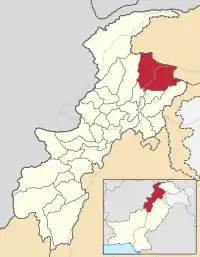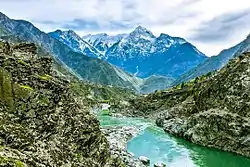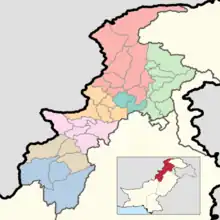Kohistan
ضلع کوہستان کوهستان ولسوالۍ | |
|---|---|
| Kohistan District | |
 Location of the former Kohistan District (highlighted in red) in Pakistan | |
| Coordinates: 35°15′N 73°30′E / 35.250°N 73.500°E | |
| Country | Pakistan |
| Province | Khyber Pakhtunkhwa |
| Division | Hazara |
| Established | 1 October 1976-2014 |
| Headquarters | Dasu |
| Area | |
| • Total | 7,492 km2 (2,893 sq mi) |
| Population (2017)[1] | |
| • Total | 784,711 |
| • Density | 100/km2 (270/sq mi) |
| Time zone | UTC+5 (PST) |
Kohistan (Urdu: کوہستان; "Land of Mountains"), also called Indus Kohistan (سندھُ کوہستان),[2][3] was an administrative district within the Hazara region of Khyber Pakhtunkhwa, Pakistan. In 2014, it was bifurcated into two districts: Upper Kohistan and Lower Kohistan. In 2017, the Lower Kohistan District was further bifurcated and a district Kolai-Palas was established.[4][5] It covered an area of 7,492 square kilometres (2,893 sq mi) and had a population of 472,570 according to the 1998 Census.[6] Geographically, Kohistan stretched from Gilgit-Baltistan in the north to the Mansehra District in the east to the Battagram District and Shangla and Swat districts in the west.[7]
Geography
The district lied between 34° 54′ and 35° 52′ north latitudes and 72° 43′ and 73° 57′ east longitudes.[7] It was bounded by the Diamer District of Gilgit-Baltistan in the north, Manshera District in the southeast, Kaghan Valley of the Mansehra District in the southeast , Battagram District in the south and Shangla and Swat Districts in the west .[7]

Kohistan is the point of convergence for the Hindukush, Karakorum and Himalayan mountain ranges, acting as a natural boundary delineating distinct environmental regions within the expanse of the Himalayas, Karakoram, and Hindu Kush mountain chains.[7] This uniqueness of the mountain system also results in rich flora and fauna, thus providing a habitat for unique species such as the Western Tragopan pheasant and the snow leopard.[7]
Education
The literacy rate of the district among the population aged 10 years and above is 11.1%: male 17.23% and female 2.95%. The proportion of working or employed population to population aged 10 years and above is 26.47% which is 70.53% of the total labor force. Out of the total employed population, 71.60% are self-employed, 10.68% work as employees, and 17.32% are unpaid family helper.
Kohistan's literacy rate is amongst the lowest in Pakistan and hovers around 20%.[8] It has the lowest Human Development Index of all districts in the Khyber Pakhtunkhwa.
See also
References
- ↑ "DISTRICT WISE CENSUS RESULTS CENSUS 2017" (PDF). www.pbscensus.gov.pk. Archived from the original (PDF) on 29 August 2017.
- ↑ Frembgen, Jürgen Wasim (1999). "Indus Kohistan An Historical and Ethnographie Outline". Central Asiatic Journal. 43 (1): 70–98. ISSN 0008-9192. JSTOR 41928174.
- ↑ Karandashev, Victor (24 December 2016). Romantic Love in Cultural Contexts. Springer. p. 189. ISBN 978-3-319-42683-9.
- ↑ Report, Bureau (16 January 2014). "KP govt creates new Kohistan district". DAWN.COM.
- ↑ "Kolai-Palas notified as new district". www.thenews.com.pk. 26 August 2017.
- ↑ "Brochure of District Kohistan NWFP" (PDF). 1998.
- 1 2 3 4 5 Kanga, Shruti; Singh, Suraj Kumar; Meraj, Gowhar; Farooq, Majid (15 February 2022). Geospatial Modeling for Environmental Management: Case Studies from South Asia. CRC Press. p. 287. ISBN 978-1-000-53920-2.
- ↑ "Archived copy" (PDF). Archived from the original (PDF) on 13 November 2010. Retrieved 28 September 2010.
{{cite web}}: CS1 maint: archived copy as title (link)
